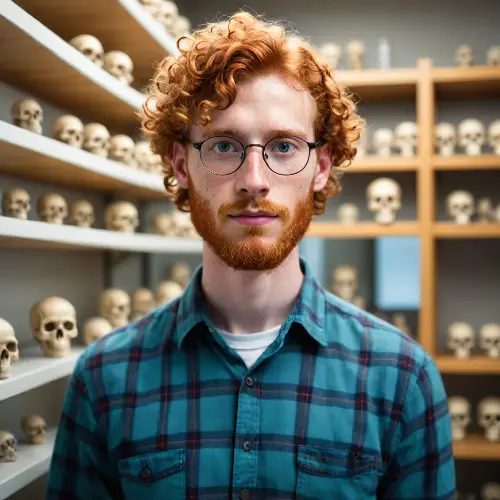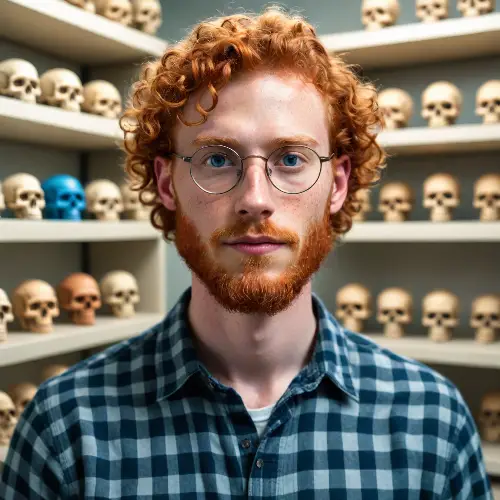imagine you have two things that look different but share some hidden similarities, like a whales flipper and a human arm. Homology theory is like a detective kit for scientists—it helps them figure out these hidden connections. It looks at structures in different creatures and finds patterns, showing how even though things might seem different on the outside, they could have come from a common ancestor way back in history. Its like solving a puzzle to discover the family tree of living things!
More Like This
imagine you have two things that look different but share some hidden similarities, like a whales flipper and a human arm. Homology theory is like a detective kit for scientists—it helps them figure out these hidden connections. It looks at structures in different creatures and finds patterns, showing how even though things might seem different on the outside, they could have come from a common ancestor way back in history. Its like solving a puzzle to discover the family tree of living things!
imagine you have two things that look different but share some hidden similarities, like a whales flipper and a human arm. Homology theory is like a detective kit for scientists—it helps them figure out these hidden connections. It looks at structures in different creatures and finds patterns, showing how even though things might seem different on the outside, they could have come from a common ancestor way back in history. Its like solving a puzzle to discover the family tree of living things!
imagine you have two things that look different but share some hidden similarities, like a whales flipper and a human arm. Homology theory is like a detective kit for scientists—it helps them figure out these hidden connections. It looks at structures in different creatures and finds patterns, showing how even though things might seem different on the outside, they could have come from a common ancestor way back in history. Its like solving a puzzle to discover the family tree of living things!
imagine you have two things that look different but share some hidden similarities, like a whales flipper and a human arm. Homology theory is like a detective kit for scientists—it helps them figure out these hidden connections. It looks at structures in different creatures and finds patterns, showing how even though things might seem different on the outside, they could have come from a common ancestor way back in history. Its like solving a puzzle to discover the family tree of living things!
imagine you have two things that look different but share some hidden similarities, like a whales flipper and a human arm. Homology theory is like a detective kit for scientists—it helps them figure out these hidden connections. It looks at structures in different creatures and finds patterns, showing how even though things might seem different on the outside, they could have come from a common ancestor way back in history. Its like solving a puzzle to discover the family tree of living things!
a striking and atmospheric scene that appears to be from a science fiction or fantasy setting. The central figure is a man, dressed in a cold-weather jacket and a beanie, crouching next to an enormous, fantastical creature with fish-like characteristics. The creature seems to be a cross between a fish and perhaps a prehistoric entity, with a large mouth filled with sharp teeth, and a heavily textured, scale-like skin that suggests age or a rugged life. The backdrop is dark and moody, with blue tones that suggest an underwater or icy environment. It appears that the creature is behind a glass partition, as we can see reflections and the rivulets of water streaming down it, giving the impression that this scene could be taking place in an aquarium or a research facility. The man's expression is one of fascination or contemplation as he gazes at the creature, which contributes to the narrative quality of the image, hinting at a story of discovery, exploration, or a connection between species. The overall effect is cinematic and filled with a sense of wonder and the uncanny, inviting viewers to imagine the story behind this moment.
a striking and atmospheric scene that appears to be from a science fiction or fantasy setting. The central figure is a man, dressed in a cold-weather jacket and a beanie, crouching next to an enormous, fantastical creature with fish-like characteristics. The creature seems to be a cross between a fish and perhaps a prehistoric entity, with a large mouth filled with sharp teeth, and a heavily textured, scale-like skin that suggests age or a rugged life. The backdrop is dark and moody, with blue tones that suggest an underwater or icy environment. It appears that the creature is behind a glass partition, as we can see reflections and the rivulets of water streaming down it, giving the impression that this scene could be taking place in an aquarium or a research facility. The man's expression is one of fascination or contemplation as he gazes at the creature, which contributes to the narrative quality of the image, hinting at a story of discovery, exploration, or a connection between species. The overall effect is cinematic and filled with a sense of wonder and the uncanny, inviting viewers to imagine the story behind this moment.
Figure Title: Dynamic Feedback Loop in [Specify the System or Process] Caption: Figure 1: Illustration of a standard feedback loop within the [Specify System or Process]. Arrows indicate the direction of influence. Description: This figure visually represents a standard feedback loop inherent in the [Specify System or Process], showcasing the dynamic interactions between its key components. The feedback loop is crucial for understanding the system's self-regulating behavior. 1. Components: The figure comprises three main components: [Input], [Process], and [Output]. [Input] represents the initial stimuli or conditions that initiate the process. [Process] embodies the series of actions or transformations that occur within the system. [Output] denotes the resulting outcomes or effects produced by the system. 2. Arrows and Directionality: Arrows connect the components, indicating the flow of information or influence. An arrow from [Input] to [Process] signifies the impact of external factors on the ongoing process. An arrow from [Process] to [Output] represents the outcomes generated by the system. 3. Feedback Loop: A loop is formed by an additional arrow from [Output] back to [Input]. This loop signifies the feedback mechanism, wherein the system's outputs influence its inputs, creating a continuous cycle. Positive feedback amplifies deviations from the system's equilibrium, potentially leading to dynamic behavior. Negative feedback dampens deviations, promoting stability within the system. 4. Labels and Annotations: Each component is labeled clearly, ensuring easy identification. Relevant annotations provide additional information about specific processes or feedback mechanisms. 5. Time Dimension: The figure may include a temporal element, with the progression of time depicted along the feedback loop. This emphasizes the dynamic nature of the system and how it evolves over time. 6. Contextualization: A brief description in the main text contextualizes the figure, explaining its relevance to the overall study. The figure might be referenced when discussing system behavior, adaptability, or response to external stimuli. 7. Aesthetic Considerations: The figure maintains a clear and professional aesthetic, adhering to any formatting guidelines specified by the journal. Colors, if used, are chosen purposefully to enhance clarity without sacrificing scientific rigor. By incorporating these elements, the figure effectively communicates the concept of a standard feedback loop in the specified system or process. It serves as a valuable visual aid for readers to grasp the interconnected dynamics and regulatory mechanisms at play within the scientific context.
Journey Through Ages: Unraveling History, Science, Politics, Gastronomy \u0026 Beyond in a Tapestry of Explanation
a young man with curly red hair and a neatly groomed red beard. He is wearing round glasses with a thin frame, through which his blue eyes are looking directly at the camera, giving a sense of engagement with the viewer. His expression is neutral, with a closed mouth and a calm demeanor. He is dressed in a casual plaid shirt with a collar, suggesting a relaxed, perhaps academic setting. Behind him, there are shelves with various objects that resemble skulls and skeletal parts, which could indicate that he is in a laboratory, classroom, or a place of study related to biology or anthropology. The lighting is soft and diffused, providing a clear view of his features without harsh shadows. The background is out of focus, ensuring the man's face is the central point of interest in the composition. Overall, the photo conveys a sense of quiet confidence and intellectual curiosity.
a close-up of a pale, textured surface that appears to be abone with a distinct marking that resembles a footprint. The imprint has three elongated toe-like depressions with pointed ends, which could be indicative of a track left by a bird or a small dinosaur. The surface around the imprint is rough and speckled with darker spots, suggesting age or weathering, and it has a slightly irregular shape, contributing to its natural appearance. The lighting is focused on the imprint, casting shadows within the depressions and emphasizing the contours of the mark, which adds depth and makes the footprint stand out against the lighter background of the material. The overall impression is that of a fossilized footprint or a natural impression captured in the surface, which could be of significant interest in paleontological studies.
a close-up of a pale, textured surface that appears to be abone with a distinct marking that resembles a footprint. The imprint has three elongated toe-like depressions with pointed ends, which could be indicative of a track left by a bird or a small dinosaur. The surface around the imprint is rough and speckled with darker spots, suggesting age or weathering, and it has a slightly irregular shape, contributing to its natural appearance. The lighting is focused on the imprint, casting shadows within the depressions and emphasizing the contours of the mark, which adds depth and makes the footprint stand out against the lighter background of the material. The overall impression is that of a fossilized footprint or a natural impression captured in the surface, which could be of significant interest in paleontological studies.
A microscopic explorer observed the intricate patterns and designs within populations of bacteria through a high-powered electron microscope, their elaborate cellular structures and organizational motifs expressed through a vivid fusion of micrograph images, abstract artistic renderings and imaginative anthropomorphizations in a thought-provoking multimedia composition illuminated by the cold, clarifying light of scientific inquiry.
Using DNA double helix structure as the basic element and presenting the concepts of connection and discovery with concise lines. Colors can be chosen from warm or cool tones, such as blue or green, to reflect the concepts of science and health. Finally, ensure that the logo can be clearly displayed in different sizes and backgrounds to ensure visibility and recognition.
a young man with curly red hair and a neatly groomed red beard. He is wearing round glasses with a thin frame, through which his blue eyes are looking directly at the camera, giving a sense of engagement with the viewer. His expression is neutral, with a closed mouth and a calm demeanor. He is dressed in a casual plaid shirt with a collar, suggesting a relaxed, perhaps academic setting. Behind him, there are shelves with various objects that resemble skulls and skeletal parts, which could indicate that he is in a laboratory, classroom, or a place of study related to biology or anthropology. The lighting is soft and diffused, providing a clear view of his features without harsh shadows. The background is out of focus
Imagine an intricate digital tapestry displayed on a computer screen, illustrating the nuanced process of randomization. At the forefront, a dynamic flowchart unfolds, showcasing a sequence of logical steps. The tapestry commences with the random generator delving into the parameters of the level's general and ambient environment, symbolized by nodes representing environmental factors. As the generator navigates through subsequent nodes, it distinguishes common occurrences, depicted by vibrant pathways, from less frequent actions illustrated by narrower trails. Anomalies, representing rare outcomes, emerge as ethereal bursts of color, emphasizing their scarcity. The tapestry not only visually encapsulates the meticulous structure but also conveys a sense of purpose and meaning behind the randomness, turning a seemingly chaotic process into an artful and purposeful creation.
Imagine an intricate digital tapestry displayed on a computer screen, illustrating the nuanced process of randomization. At the forefront, a dynamic flowchart unfolds, showcasing a sequence of logical steps. The tapestry commences with the random generator delving into the parameters of the level's general and ambient environment, symbolized by nodes representing environmental factors. As the generator navigates through subsequent nodes, it distinguishes common occurrences, depicted by vibrant pathways, from less frequent actions illustrated by narrower trails. Anomalies, representing rare outcomes, emerge as ethereal bursts of color, emphasizing their scarcity. The tapestry not only visually encapsulates the meticulous structure but also conveys a sense of purpose and meaning behind the randomness, turning a seemingly chaotic process into an artful and purposeful creation.
Imagine an intricate digital tapestry displayed on a computer screen, illustrating the nuanced process of randomization. At the forefront, a dynamic flowchart unfolds, showcasing a sequence of logical steps. The tapestry commences with the random generator delving into the parameters of the level's general and ambient environment, symbolized by nodes representing environmental factors. As the generator navigates through subsequent nodes, it distinguishes common occurrences, depicted by vibrant pathways, from less frequent actions illustrated by narrower trails. Anomalies, representing rare outcomes, emerge as ethereal bursts of color, emphasizing their scarcity. The tapestry not only visually encapsulates the meticulous structure but also conveys a sense of purpose and meaning behind the randomness, turning a seemingly chaotic process into an artful and purposeful creation.
a group of people in a dessert setting observing the realistic skeleton of a large, dragon-like creature. The creature's skeleton is the centerpiece, mounted on a platform that simulates a natural environment with a rocky and sandy surface. The skeleton is notable for its large size, elongated body, prominent ribcage, and a long tail that tapers to a point. It has four limb skeletons, indicating that the creature was quadrupedal. The skull of the creature is particularly striking, with an array of menacing, sharp teeth and pointed structures around its head, which could suggest horns or frills. The museum visitors are dressed in casual clothing, and their attention is focused on the impressive skeletal display, indicative of interest and curiosity. The lighting in the scene is soft, casting gentle shadows and giving the space a calm ambiance.
Imagine an image of diverse human silhouettes against a backdrop of evolving gears and cogs, symbolizing the relentless innovation of ideas. Each silhouette represents a facet of human endeavor—ideas, fantasies, systems, and tools—while the intricate machinery behind them depicts the continuous evolution of these concepts. The gears symbolize progress, with each revolution signifying a step toward fulfilling fundamental human needs. The varying sizes and shapes of the gears signify the constant pursuit of improvement—something bigger, deeper, or more refined.
Imagine an image of diverse human silhouettes against a backdrop of evolving gears and cogs, symbolizing the relentless innovation of ideas. Each silhouette represents a facet of human endeavor—ideas, fantasies, systems, and tools—while the intricate machinery behind them depicts the continuous evolution of these concepts. The gears symbolize progress, with each revolution signifying a step toward fulfilling fundamental human needs. The varying sizes and shapes of the gears signify the constant pursuit of improvement—something bigger, deeper, or more refined.



















































































